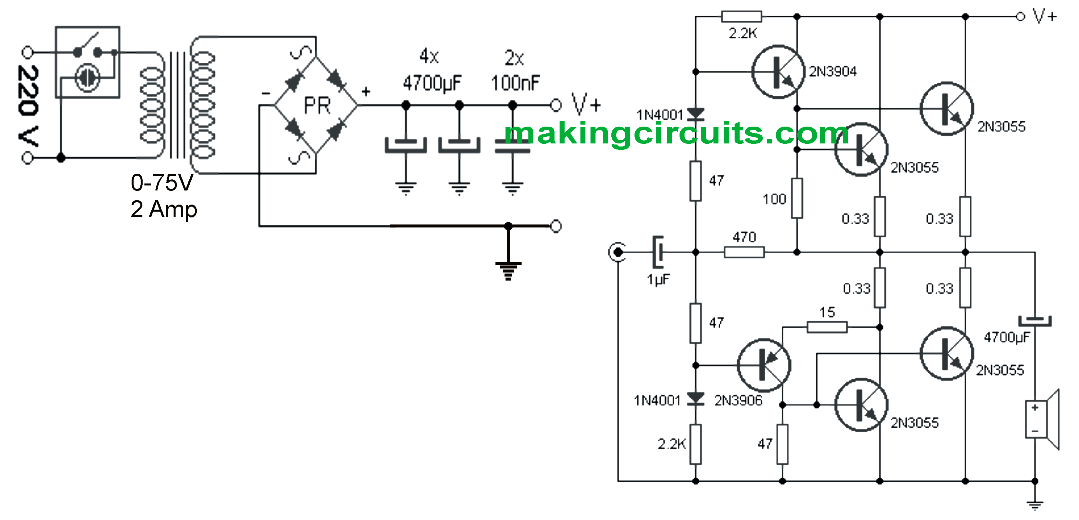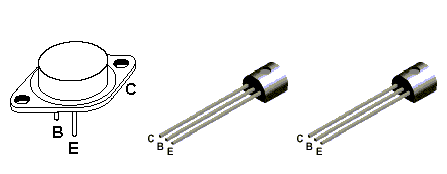Here we learn how to make a very simple 100 watt amplifier circuit using a 2N3055 transistors and a few other passive components.
Simply by incorporating just four transistors in the quasi-complementary configuration this 2N3055 simple power amplifier circuit can deliver a good 100 watts of power over an attached 4 ohms loud speaker, and the entire design can be built at a really low cost (to be precise it would cost you only 1/2$ per transistor).

As exhibited in the above diagram you won't find no costly or obsolete hard to find components in this amplifier circuit, except the power supply transformer and possibly the 4 ohm loud speaker.
The input stage is created by configuring a couple of current drivers transistor stages responsible for triggering the pairs of power BJTs positioned at the output stage.
The 2N3055 power stage at the output should be mounted on large heat sinks to ensure that this crucial stage is able to dissipate adequately and function with optimal efficiency.
The a power supply of 80V, it becomes necessary to put a series capacitor in between the output stage and the speaker in order to block the DC supply from entering the speaker and allowing only the amplified 100 watt music power.
For a mono 100 watt amplifier the power supply could be rated at 1.5A , for stereo this needs to be doubled at 3 amps, and in case a quadraphonic amplifier is required then make sure to use transformer rated to handle a minimum of 6 amp.
The following diagram shows the pinout details of the various transistors used in this simple 100 watt amplifier circuit using 2N3055 transistors

I build this amplifier but get no audio out, did check all my connections over again. Please tell me the lowest voltage that this amplifier will start on? I tried 32v just to make sure everything is up and running but no luck. Also the speaker wire, for under 80v must the 4700mfd capacitor ommitted or not?
thank you so much
Cobus
The lowest voltage can be 12V. The 4700uF capacitor is compulsory, it cannot be omitted.
disconnect the base of 2n3096 and connect between 2.2k and diode. at 12 volt supply not much sound
2N3055 can’t handle 80 volts – 70 volts tops. Vce rating is 60v but you could squeeze a little more by running a 50v ac secondary into a bridge and smoothing to give around 71 volts off load. Any more and these things would pop regularly. Their main utility is that they could handle 15 amps.
You are right, in that case you can replace them with TIP35
dear sir do you have any amplifier circuit for public address loudspeakers (Horns) ?
yes I may be having it, will check and let you know….
Pls how do make simple power amp using two 2n3055,one capacitor and one resistor
what is the wattage of 0.33 ohm resistors please? is it 5w?
they are all 1 watt rated
Bonjour,
Votre schéma amplificateur est-il HI-FI?
Cordialement.
Bonjour,
Oui c’est Hi Fi
I made this circuit (almost identical) 50 years ago with only one set of 3055’s (yes I am 72) It is very robust I still use it every day…..Use good quality caps.
could you tell me the wattage of resistance 0.33 thank you, god bless you
you can use 3 watt resistors
To have 100 W ( RMS ? ) how many mV should be the audio input ?
The Arrangement seem to have a gain of (just) 4 dB . So i suppose the input should be at least ( also depending of speker impedance ) 12 Vp/p . Right ?
yes that’s correct!
this amplifier has no dc gain! i simulated it
Hello, should this not have PNP and NPN in the output buffer too?
I did not think about it at first so just went with NPN and got no output.
Are you getting output with PNP? According to me the original diagram is correct.
Bord me (-)vold kaha dunga
speaker ground line par!
Can it still deliver 100 watts by using a 8ohm instrumental speaker
Hi is this really work?… what transistor can be replaced to 3904/3906.. its because not available to my country TIA .. reply will be appreciated thanks!
thanks dix you can replace them with 2N2222 and 2N2907
The 3906 and 3904 transistor bases are incorrectly wired to the input circuit. They should be connected to the cathode side of their respective diodes not the anodes.
Kindly make clear the rated voltage of 4700 uf capacitors
it should be twice of the transformer voltage rating
In the above 2N3055 100 watt simple power amplifier; should the 1N4001 diodes be mounted on the heatsink with the power transistors?
please use 6A4 diodes instead, 1N4001 may burn due to over current
I am sorry, I thought you were referring to the bridge diodes…the 1N4001 diodes will not require any heatsink
That will work for me; thanks!!!!! 🙂
You are welcome!!